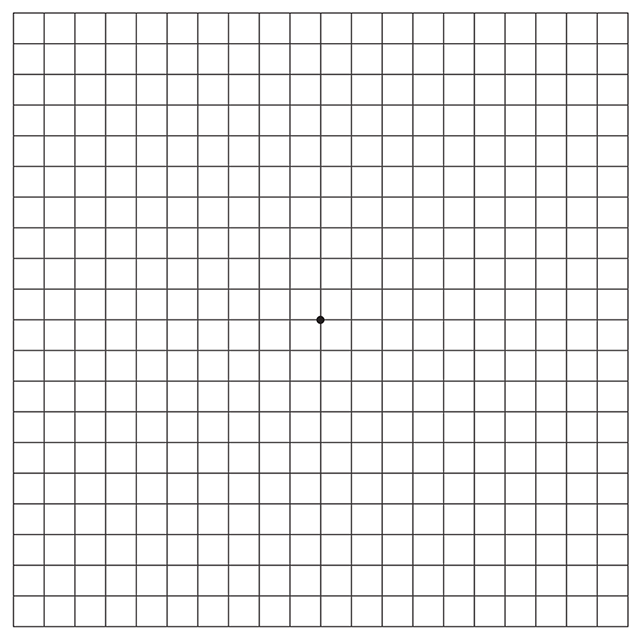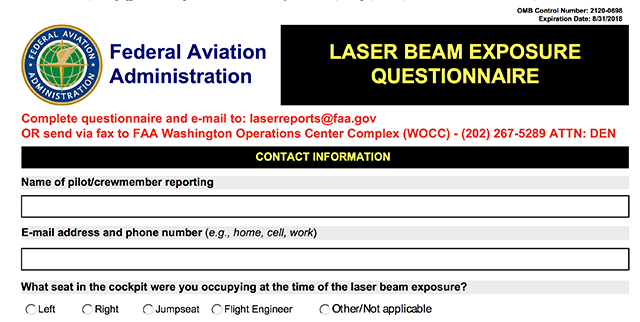I've never noticed a laser beam aimed my way in an airplane but understand it is quite a problem. Some of my friends in the airlines say it is an over-hyped issue while others say it is only a matter of time before a pilot is injured permanently and an airplane is put into jeopardy.
— James Albright

Updated:
2017-11-12
This from a friend near Denver: Denver 9 News. Here is what I have learned so far
3 — Aircrew mitigation procedures

1
The regulations
(a) OFFENSE -- Whoever knowingly aims the beam of a laser pointer at an aircraft in the special aircraft jurisdiction of the United States, or at the flight path of such an aircraft, shall be fined under this title or imprisoned not more than 5 years, or both.
(b) LASER POINTER DEFINED -- As used in this section, the term `laser pointer' means any device designed or used to amplify electromagnetic radiation by stimulated emission that emits a beam designed to be used by the operator as a pointer or highlighter to indicate, mark, or identify a specific position, place, item, or object.
(c) EXCEPTIONS -- This section does not prohibit aiming a beam of a laser pointer at an aircraft, or the flight path of such an aircraft, by--
(1) an authorized individual in the conduct of research and development or flight test operations conducted by an aircraft manufacturer, the Federal Aviation Administration, or any other person authorized by the Federal Aviation Administration to conduct such research and development or flight test operations;
(2) members or elements of the Department of Defense or Department of Homeland Security acting in an official capacity for the purpose of research, development, operations, testing or training; or
(3) by an individual using a laser emergency signaling device to send an emergency distress signal.
(d) The Attorney General, in consultation with the Secretary of Transportation, may provide by regulation, after public notice and comment, such additional exceptions to this section, as may be necessary and appropriate. The Attorney General shall provide written notification of any proposed regulations under this section to the Committees on the Judiciary of the House and Senate, the Committee on Transportation and Infrastructure in the House, and the Committee on Commerce, Science and Transportation in the Senate not less than 90 days before such regulations become final.
Source: U.S.C. TITLE 18, CHAPTER 2, §39A. Aiming a laser pointer at an aircraft
2
Don't panic!
Don't panic? Easy for me to say. Your need your eyes to make a living after all!
It is extremely unlikely that a laser beam exposure will result in permanent eye damage. Eye discomfort and irritation during the exposure is common and rubbing your eye can result in an abrasion that may be painful. If you have experienced one or more of the following after a laser beam exposure please consult an eye specialist: Eye problems – swelling, pain, itching, watering, discharge, dryness or redness of the eye. Visual disturbance – blurring, black spot, trouble reading, loss of peripheral vision, floaters, halos, poor night vision, sensitivity to light. These symptoms may not appear until hours after the incident and may not be related directly to laser exposure but could reflect other eye issues perhaps not previously noticed.
Source: UK CAA
- The primary concern of safety experts is the problem of visible lasers that can cause “visual interference” with pilot performance during critical phases of flight. They have identified three main visual interference hazards: 1) temporary flashblindness, 2) glare and disruption, and 3) distraction.
- Fortunately, it is very unlikely for eye injuries to occur from consumer-type lasers, or even from more powerful light show lasers. Of the tens of thousands of reported laser/aircraft incidents, only in less than 1% of cases have there been reported laser eye injuries (adverse changes to the retina) and eye effects (watering eyes, pain that dissipates). Many or most injury reports are questioned by recognized laser safety experts. For example, the injuries could have been pre-existing or could have been caused by non-laser factors such as rubbing the eye after an exposure. In a very few cases, minor injuries have healed — just as skin heals after a small cut or burn — with no ill effect on vision. As for permanent eye injuries, these appear to be non-existent.
Source: http://laserpointersafety.com/aviation/laser-hazards/index.html
There are many who will dispute the claim that permanent eye injuries "appear to be non-existent." See: Denver 9 News for one example of many.
- In the United States, lasers sold for pointing uses cannot exceed 5 mW.
- It is a potential eye hazard from the pointer to about 52 feet.
- It is a temporary flashblindness hazard from the pointer, out to about 260 feet. On the diagram, this is illustrated in the inset photo “Near-flashblindness” which shows what a 5 mW laser looks like at 350 feet.
- It causes glare and is a disruption hazard from about 260 feet to about 1,200 feet. This is shown in the “Glare” inset photo where the runway is not visible.
- It is a distraction hazard from the pointer to over two miles (11,700 feet). The distraction can be dangerous during a critical phase of flight, such as takeoffs and landings. Note that this is not truly “visual” interference, since a pilot can see despite the light. Instead, it is a mental distraction, interfering with the pilot’s attention. This can be overcome if a pilot is aware of laser hazards, and how to react to them (e.g., ignoring low-level laser distractions).
Source: http://laserpointersafety.com/aviation/laser-hazards/index.html
Recommendations.
- If warned, protect your passengers by closing the cabin blinds.
- If you experience a laser strike, it may initially feel like you have been "snapped in the eye with a rubber band" followed by the feeling of "sand being thrown into your eyes."
- Immediately take two Advil to help reduce inflammation and permanent eye damage. Do not rub your eyes.
3
Aircrew mitigation procedures
Although unauthorized laser illumination is difficult to predict there are certain practical actions aircrews should consider before, during, and after encountering laser activity.
- Pilots should avoid flight within areas of reported ongoing unauthorized laser activity to the extent practicable.
- In the event a cautionary broadcast (by ATC or another pilot) regarding unauthorized laser illumination is made within the previous 20 minutes for a particular area, pilots should avoid the area, if practicable.
- In the event laser activity is encountered or reported in the vicinity of flight, pilots operating in accordance with instrument flight rules (IFR) should obtain ATC authorization prior to deviating from their assigned clearance.
- In the event aircrews are unexpectedly exposed to laser illumination, direct eye contact with the beam should be avoided, and eyes should be shielded to the maximum extent possible consistent with aircraft contract and safety. ATC understands that, under these circumstances, aircrews may regard the event as an in-flight emergency and may take evasive action to avoid further exposure to the laser illumination.
- As soon as possible, following an incident, pilots should report it to the appropriate ATC facility in accordance with the guidance provided by this AC. Forward as much information as available. Expeditious reporting will assist law enforcement in locating the source of the laser transmission.
Source: AC 70-2A, ¶7.a.
See Reporting, below, for more on this.
4
Should you seek medical attention?
If you think you've had a laser shot to your eyes you might need medical attention. The UK CAA has a self assessment to help you decide if you should seek medical help. Click on the grid for a copy of the self-assessment.
5
Notification
If there has been a reported laser illumination in an ATC facilities area within the previous 20 minutes, they are required to let you know.
If the laser event occurs in the vicinity of an FAA ATC terminal facility, ATC will broadcast on appropriate control frequencies a general caution about reported incidents of unauthorized laser illumination of aircraft. These cautions will be broadcast every 5 minutes for 20 minutes (four times) after each reported event. Cautionary broadcasts will include the following:
- Phrase “UNAUTHORIZED LASER ILLUMINATION EVENT.”
- General positional information (e.g., location and altitude).
Source: AC 70-2A, ¶5.c
6
Reporting a laser incident
The U.S. FAA tracks laser incidents. Click on the photo to be taken to their tracking form.
- All aircrews are requested to immediately report incidents of unauthorized laser illumination by radio to the appropriate ATC controlling facility. Reports should include event position (e.g., latitude/longitude and/or FRD), altitude, color of laser beam(s), originating direction, and any other information believed necessary for ATC, law enforcement, and other governmental action taken to safeguard the safety and efficiency of aviation operations in the NAS.
- Aircrews flying in uncontrolled airspace are requested to immediately broadcast a general laser illumination caution on the appropriate UNICOM frequency. This general caution should include the following:
- Phrase “UNAUTHORIZED LASER ILLUMINATION EVENT.”
- Event time in UTC, general positional information (e.g., location and altitude).
- General description of event (e.g., color, intensity, and direction of beam).
- On arrival at destination, all aircrews that have been affected by an unauthorized laser illumination are requested to complete the Laser Beam Exposure Questionnaire. The questionnaire is located on the FAA’s Laser Safety Initiative Web site at http://www.faa.gov/about/initiatives/lasers/ and can be electronically submitted. The questionnaire may also be printed and faxed to the WOCC at (202) 267-5289, ATTN: DEN, or emailed to laserreports@faa.gov.
Source: AC 70-2A, ¶6
References
(Source material)
Advisory Circular 70-2A, Reporting of Laser Illumination of Aircraft, February 8, 2013, U.S. Department of Transportation
FAA Laser Beam Exposure Questionnaire
http://laserpointersafety.com/aviation/laser-hazards/index.html


